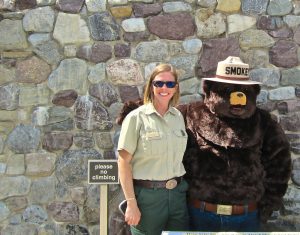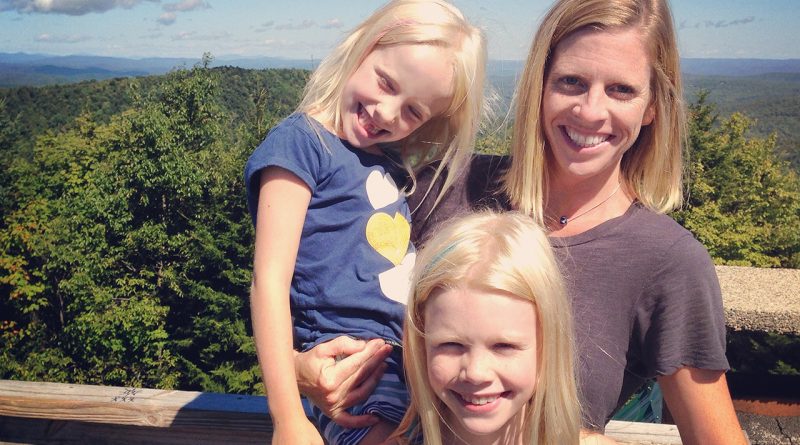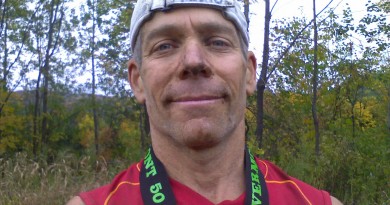Holly Knox: Queen of the Green Mountain National Forest
Holly Knox knows where the best trails are because she spends a lot of time in the Green Mountain National Forest. It’s her job to look for recreational opportunities within the forest and help make them a reality. Luckily, she gets to sample some of the trails she has worked on in running shoes, hiking boots, snowshoes, on skis and by bicycle.

Name: Holly Knox Age: 40
Lives in: Stockbridge
Family: Husband, Ryan; daughters, Logan (10) and Maggie (8)
Occupation: Recreation Program Manager for the Rochester and Middlebury Ranger Districts in the Green Mountain National Forest
Primary sport: Running
VS: Just how big is the Green Mountain National Forest?
HK: The Green Mountain National Forest is 400,000 acres in central and southern Vermont that are split into three districts: Manchester, Middlebury and Rochester and it includes eight wilderness areas. We’re also responsible for the Finger Lakes National Forest, just southwest of Syracuse, in New York. Our trails are used for Nordic, alpine and backcountry skiing, mountain and fat tire biking, running, snowshoeing and horseback riding. We also have paddle sports at several lakes and reservoirs.
VS: I want to start by asking you about your job. What does it mean to “analyze new recreation opportunities?”
HK: We look for emerging opportunities for new sports like backcountry skiing and fat biking and try to see where can we accommodate those activities. We rely on partners to help us. For example, we’re currently working on the Robinson Integrated Resource Project, which is primarily in Rochester. We had a public meeting and asked what people wanted to see in that area. We heard that there wasn’t much for horseback riders so that begs the question of whether we should improve current trails or perhaps build new ones and whether we should do things like make the campsites more horse-friendly.
VS: How do you decide where to make trails?
HK: We generally move our integrated resource projects from area to area, look for program opportunities and then talk to potential partners. A recent project is the Brandon Gap Backcountry Recreation Area. We talked to Rochester Area Sports Trails Association (RASTA) and the Catamount Trail Association and others to learn where skiing was already taking place, where there was parking, and where there were potential problem areas where people might end up on the wrong side of the mountain. In this case, we knew there was skiing because we saw unauthorized cutting so the goal is to maintain the ecological integrity of the area and do some restoration work. We’re calling this area a backcountry ski zone. We don’t have trail signs but we have opened the canopy enough that people can pick their lines.
VS: Can you explain the different considerations for different kinds of trails, i.e., mountain biking, hiking, skiing?
HK: We try to combine uses on trails but there are certainly different needs for different sports. Mountain biking used to be on old skid trails but now riders are more interested in single track. Horses need higher clearance and more space so they can move to the side to let others pass. Fat bikes need a compacted, groomed winter trail surface. Each trail has its unique assets but we can have multiple uses.
VS: Backcountry skiing has gotten more popular in Vermont. Can you talk about the pros and cons of creating more trail systems for skiers?
HK: Whether the pros outweigh the cons or vice versa depends on who you ask. We know that the demand exists and if you don’t provide the opportunity, people will still find ways to make it happen with illegal cutting. If we can develop a good partnership, we can prevent that from happening. There are concerns that more lines will be cut because we’ve drawn people to the area and there are concerns about the effect on wildlife, particularly moose. We take these concerns very seriously so we’ve partnered with Dartmouth College which will analyze moose scat after fresh storms when the skier traffic is heaviest and look at the moose hormone stress levels. We also monitor the area to ensure that after the cutting it won’t be overcome by ferns which would then make it hard for the softwood to regenerate.
VS: Have there been any major policy changes over the last few years?
HK: As recreation trends develop, the National Forest Service must adapt to new trends and user groups. While they might not be policy changes, per se, we must consider how we will manage these new uses. For example, discussions have recently taken place about whether we should allow electric bikes on mountain bike trails. The Forest Service considers them to be motorized recreation so they are currently not permitted on non-motorized trails.
VS: What are your favorite things to do in the National Forest?
HK: I love mountain biking at Blueberry Lake in Warren. I’m proud of our partnership there with the Mad River Riders. I also love to hike and run on our trails. I enjoy backcountry skiing but I’m not ready for the Brandon Gap yet. I’ve pretty much done all the sports one can except horseback riding.
VS: When is the best time to work on trails and how can people volunteer to help?
HK: Fall is definitely the busiest time on the trails because it’s a beautiful time to be out and that’s when we get volunteers. During the summer we’re more dependent on staff and the wonderful crews from the Vermont Youth Conservation Corps. But we really love our volunteers. Our program would be devastated without them. Our greatest base is those who work on the trails and the best way to do that is through our partner organizations like RASTA, VAST, CTA and bicycling groups but we also have volunteer campground hosts. Without our community of collaborators, we would not be able to provide so many recreational opportunities.
VS: I’m intrigued by your work with urban youth. Can you talk a bit about that?
HK: I’m enormously proud of that. Last summer we worked with the Lexington School for the Deaf in New York City and we won an award for our partnership with them. I have a deaf colleague in Manchester, Joanel Lopez, and I’ve been so impressed with him that I wanted other deaf people to see what he’s done. I like to take on challenges so I started writing grants and I was able to bring up ten kids from the school last summer to expose them to different forestry careers. My dream was that whoever was interested would join a Vermont Youth Conservation Corps crew this summer and three of the deaf students did.
VS: How did you get into this field?
HK: I started with the National Forest Service in California on a fire ecology team. I came to Vermont to work on a long-term management plan and
then someone suggested this position. This is a perfect fit because I love collaborating with the public and that’s a big part of my job. I want to encourage people to love their national forest. This job was meant to be.
HOLLY KNOX’S PICKS
Here are her favorite places in the Green Mountain National Forest.
TRAILS
Leicester Hollow and Chandler Ridge: this loop project was one of my first undertakings when I started working in recreation and has beautiful views. Blueberry Lake: My favorite place to mountain bike and hike with the family! It is lovely to go for a dip in the lake after. Contest Trail: This trail offers an amazing view and is a perfect distance to keep kids happy!
CAMPSITES
Chittenden Reservoir paddle-in camp sites: the sites are remote and quiet, with the exception of loon calls! Silver Lake Campground for the beautiful views, proximity to water and wonderful hiking. Moosalamoo Campground because it is in the heart of the National Recreation Area


